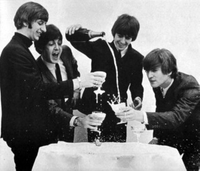Fast Forward Music >>
ABCDEFG
A(step)BC(step)D (step)EF(step)G(step)A...
A(sharp/flat)B C(sharp/flat)D(sharp/flat)E F(sharp/flat)G(sharp/flat)A...

by artau88
A(#b)BC(#b)D(#b)EF(#b)G(#b)A...
Between BC, and EF, there are no sharps/flats(#b). Remember this with Bake Cakes, Eat Food.
Sharp# raises a note a half step higher in sound. Flatb lowers a note a half step lower in sound. Natural notes have no sharp/flat.
A note that has both a flat and sharp name, like D# and Eb, is called an Enharmonic.
A Major Scale has eight notes, with these intervals between notes:
W(hole),H(alf)
WWHWWWH (2wholes, 1half, 3wholes, 1half)
C w D w E h F w G w A w B h C
C to D is: C, [C#/Db], D.
This is a whole step, because C to [C#/Db] is a half step, and [C#/Db] to D is another half step. Two Half steps equals a Whole step. (The sharp and flat note together is an Enharmonic, since it's the same tone).
Triads have the 1st, 3rd, and 5th notes of a Major Scale.
1 3 5
C E G
Use FCGDAEB to find number of sharps in a Major Key (scale notes are in this key). C Major Scale has no sharps or flats.
Lower the first(root) note of a Major Scale. Then, count up to the lower note using FCGDAEB (Fat Cats Go Down Alleys Eating Birds). The sharps that were counted are the number of sharps in the Root's Key.
ABCDEFGA has A as the root. One half step down from A is G#. Counting up to G#, we arrive at F#C#G# (fat cats go). The A Major Scale has three sharps:
ABC#DEF#G#A
A Major's triad is A C# E (1,3,5).
Use BEADGCF (opposite the sharps), to find the number of flats in a Major Key. (F Major has only Bb).
Use the Root(first note) as the second-to-last flat, counting from BEADGCF (spelling BEAD, then GCF). Count up one more flat (for the last flat), and that is the number of flats in the Root's Key.
DbEFGABCDb has Db as the root. Using Db as the second-to-last flat, count up to the last flat:
BEADG (flats)
The Db Major Scale has five flats, Bb Eb Ab Db Gb.
The scale is Db Eb F Gb Ab Bb C Db (just think C and F are natural, while flatting everything else).
Db Major's triad is Db F Ab (1,3,5).
Relative Minor Keys are three half steps down from the Major's Root (1st note). From Db Major: Db, C, B, Bb is three half steps lower, to bb minor. bb minor has the same key signature (number of flats) as Db Major (it sounds different, though).
The bb minor scale is:
bb c db eb f gb ab bb (c and f are natural)

the beatles
To make a song, string together triads, that have different roots. Progressing through each triad, the key (sharps/flats) changes (called a chord progression).
Chords reinforce the melody, or high part of a song
Melodies are just scale notes in a different order that sounds good to you (with rhythm). Pick a Root (starting) note, find its Key (sharp/flats), and arrange those notes in an original melody.
With the phrases of the melody (like a conversational sentence), find the note that most of the melody notes resolve toward (a root for that phrase). Just use that root's triad (including its key) to support that part of the melody.
When the melody phrase sounds like it needs a new root (background tone), change to the new root and its triad. You can play triad notes together in any order, 1,3,5 / 3,1,5 / 5,1,3 / 3,5,1. Write down each of your created triads so you may remember them later.
The fun part of music, is creating an impromptu (spur of the moment) melody over the changing chords (called Improvisation). Just use the same scale notes within a triad's key, quickly arrange them in a logical manner (melody), and predict the next chord change in your melodic phrases.
If you need help with the melody, memorize a few melodic phrases that appear in songs you like. Play them in the key of the background chords.
Furthermore, you may practice changing scale patterns (intervals). Thirds interval starts a scale at the root, to the 3rd note, back to the 2nd, then to the 4th, back to the 3rd, then to the 5th, etc. 1,3,2,4,3,5, 4,6,5,7,6,8,7,2octave,8
Skip more notes to make longer intervals (1,4) or (1,5) etc.
Start on any interval step, and use different rhythms. Inspiration for a new melody may flow from using scales, memorized phrases, and intervals.
The next page begins sheet music instruction, that lets you read songs others write.